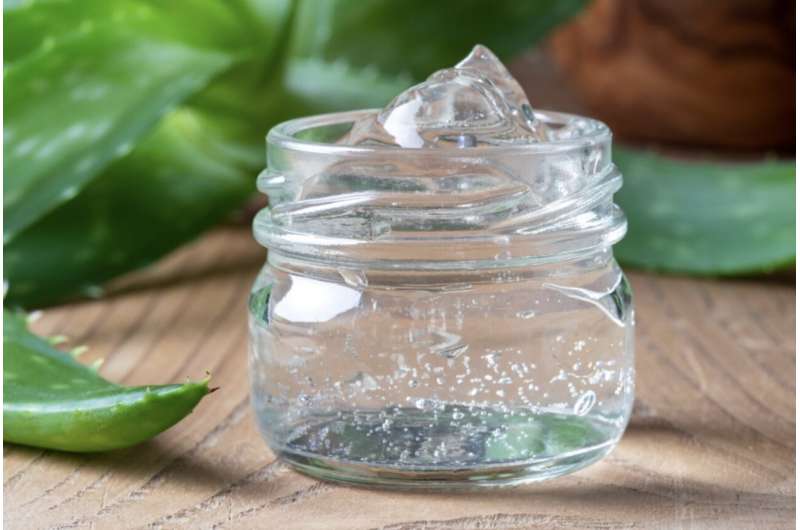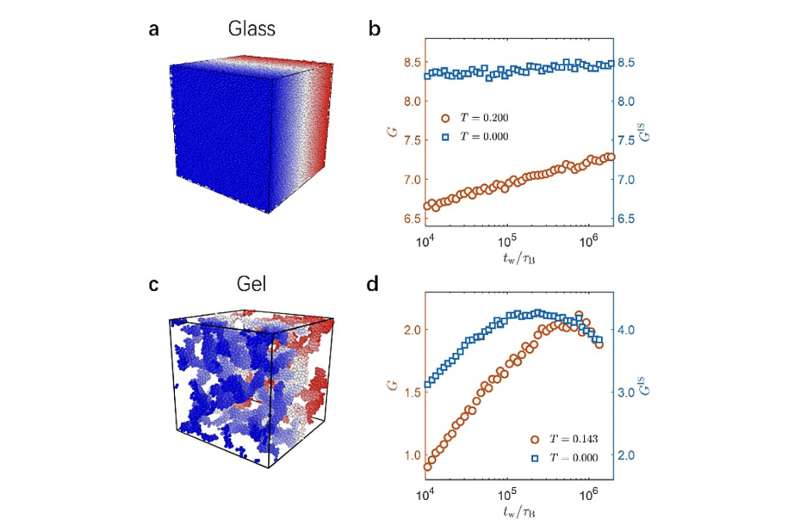
Glasses and gels are two different types of solid materials that are commonly used in a wide range of settings. Despite their markedly different compositions, these distinct materials share some similar properties, for instance, they exhibit rigidity without a translational order and a slow transformation over time.
Researchers at the University of Tokyo recently set out to better understand the differences between glasses and gels, specifically focusing on their elastic properties. Their paper, published in Nature Physics, sheds light on the origin and evolution of elasticity in these two classes of amorphous solids.
“Our research started by observing the unique mechanical changes in colloidal gels during aging,” Hajime Tanaka, senior author of the paper, told Phys.org. “Although glasses and gels have similar characteristics as amorphous solids—like rigidity without order and slowing dynamics during aging—we found something unexpected.
“While studying how the elastic modulus of colloidal gels changes with time, we discovered a surprising trend: instead of getting stiffer over time like glasses, the gels actually softened after an extended aging period—about two months for 2 μm colloidal particles.”
In their previous research, Tanaka and his collaborators gathered findings that challenged existing notions of how amorphous solids evolve over time. Specifically, their studies found that aging dynamics in these types of solids do not always lead to an increase in stiffness.
“This unexpected finding made us curious about the differences between glasses and gels and what causes them,” Tanaka explained. “Our study thus aimed to uncover the unique elastic properties of glasses and gels and understand the reasons behind them. We also wanted to learn how the relationship between structure and dynamics affects the mechanical properties of amorphous solids.”
To study the elastic properties of colloidal glasses and gels, the researchers ran three-dimensional (3D) Langevin dynamics simulations. These simulations allowed them to model both colloidal glasses characterized by repulsive particles and colloidal gels with attractive particles.

“We studied the aging process of both systems by rapidly transitioning them from equilibrium to out-of-equilibrium states,” Yinqiao Wang, first author of the paper, said. “To mimic experimental conditions, we first allowed particles in both systems to equilibrate in liquid states. Then, we quickly increased the packing fraction beyond the glass transition threshold to form colloidal glasses. Conversely, for colloidal gels, we rapidly lowered the temperature well below the gas–liquid demixing temperature.”
As they observed the aging process of the two modeled systems, the researchers carefully monitored the evolution of their elasticity, while also taking thermal fluctuations into account. This was done using small-amplitude oscillatory deformations or by directly solving the Hessian matrix.
“At the same time, we analyzed changes in vibrational dynamics and structure, including orientational order parameters and Voronoi anisotropy in glasses, as well as connectivities at particle and network scales in gels,” Tanaka explained. “Our results highlight the intricate interplay among structure, dynamics (thermal fluctuations), and elastic properties in non-equilibrium disordered systems, focusing on two typical amorphous solids: colloidal glasses and gels,”
Tanaka and his colleagues found that while glasses and gels share some similar properties as non-equilibrium amorphous solids, their elastic properties are markedly different. Their paper also elucidates some of the unique mechanisms underlying these two types of systems’ respective behaviors.
“Our work not only provides valuable insights into fundamental non-equilibrium physics but also has significant implications for materials science,” Tanaka said. “It offers a physical basis for distinguishing between glasses and gels, particularly in challenging scenarios such as non-ergodic states of Laponite suspensions.”
The recent work by this research team contributes to the understanding of the physical processes underlying elasticity in colloidal glasses and gels. The new insight it provides could soon inform the design and manufacturing of amorphous solids with desired elastic properties.
“In our future research, we will extensively investigate the mechanical properties of amorphous solids, including granular materials, repulsive/attractive glasses, and gels,” Tanaka added. “We aim to deepen our understanding of these complex disordered systems through systematic exploration, with the goal of unraveling their underlying mechanisms and implications across various material systems.”
More information:
Yinqiao Wang et al, Distinct elastic properties and their origins in glasses and gels, Nature Physics (2024). DOI: 10.1038/s41567-024-02456-6
© 2024 Science X Network
Citation:
Study sheds light on the origin of elasticity in glasses and gels (2024, May 8)
retrieved 8 May 2024
from https://phys.org/news/2024-05-elasticity-glasses-gels.html
This document is subject to copyright. Apart from any fair dealing for the purpose of private study or research, no
part may be reproduced without the written permission. The content is provided for information purposes only.







